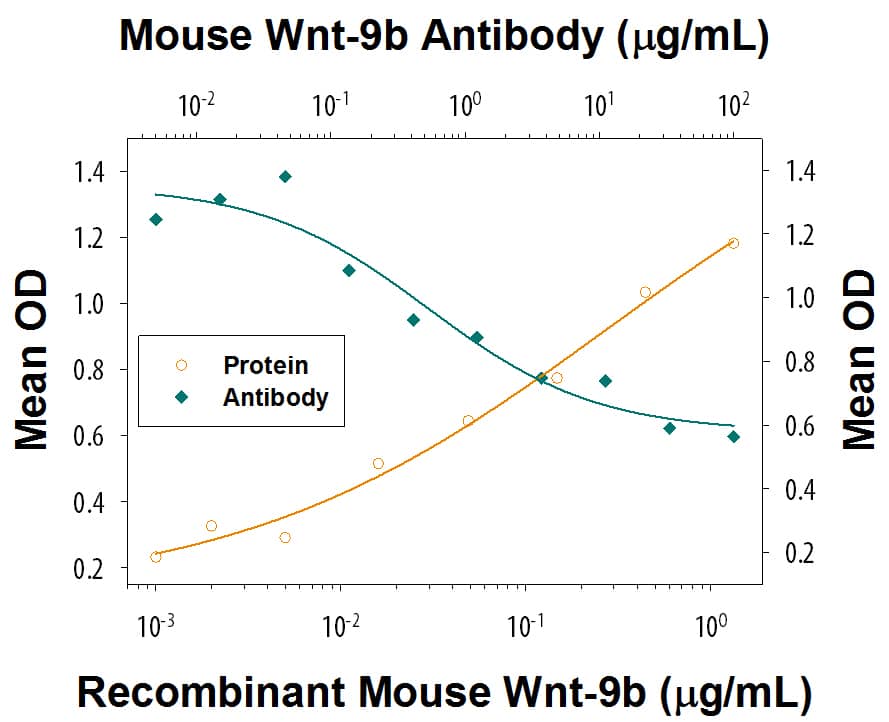Mouse Wnt-9b Antibody
R&D Systems, part of Bio-Techne | Catalog # MAB36691

Key Product Details
Species Reactivity
Mouse
Applications
Neutralization
Label
Unconjugated
Antibody Source
Monoclonal Rat IgG2B Clone # 964742
Product Specifications
Immunogen
Chinese hamster ovary cell line CHO-derived recombinant mouse Wnt-9b
Met1-Arg359
Accession # O35468
Met1-Arg359
Accession # O35468
Specificity
Detects mouse Wnt-9b in direct ELISAs.
Clonality
Monoclonal
Host
Rat
Isotype
IgG2B
Endotoxin Level
<0.10 EU per 1 μg of the antibody by the LAL method.
Scientific Data Images for Mouse Wnt-9b Antibody
Alkaline Phosphatase Production Induced by Wnt‑9b and Neutralization by Mouse Wnt‑9b Antibody.
Recombinant Mouse Wnt-9b (Catalog # 3669-WN) induces alkaline phosphatase production in the C3H10T1/2 mouse embryonic fibroblast in a dose-dependent manner (orange line). Alkaline Phosphatase Production elicited by Recombinant Mouse Wnt-9b (400 ng/mL) is neutralized (green line) by increasing concentrations of Rat Anti-Mouse Wnt-9b Monoclonal Antibody (Catalog # MAB36691). The ND50 is typically 125-750 ng/mL.Applications for Mouse Wnt-9b Antibody
Application
Recommended Usage
Neutralization
Measured
by its ability to neutralize Wnt‑9b-induced alkaline phosphatase
production in the C3H10T1/2 mouse embryonic fibroblast cell line. The
Neutralization Dose (ND50) is typically
125-750 ng/mL in the presence of 400 ng/mL Recombinant
Mouse Wnt‑9b.
Formulation, Preparation, and Storage
Purification
Protein A or G purified from hybridoma culture supernatant
Reconstitution
Reconstitute at 0.5 mg/mL in sterile PBS. For liquid material, refer to CoA for concentration.
Formulation
Lyophilized from a 0.2 μm filtered solution in PBS with Trehalose. *Small pack size (SP) is supplied either lyophilized or as a 0.2 µm filtered solution in PBS.
Shipping
Lyophilized product is shipped at ambient temperature. Liquid small pack size (-SP) is shipped with polar packs. Upon receipt, store immediately at the temperature recommended below.
Stability & Storage
Use a manual defrost freezer and avoid repeated freeze-thaw cycles.
- 12 months from date of receipt, -20 to -70 °C as supplied.
- 1 month, 2 to 8 °C under sterile conditions after reconstitution.
- 6 months, -20 to -70 °C under sterile conditions after reconstitution.
Background: Wnt-9b
References
- http://www.stanford.edu/group/nusselab/cgi-bin/wnt/.
- Logan, C. Y. and R. Nusse (2004) Annu. Rev. Cell Dev. Biol. 20:781.
- Kirikoshi, H. and M. Katoh (2002) Int. J. Mol. Med. 9:135.
- Qian, J. et al. (2003) Genomics 81:34.
- Carroll, T. J. et al. (2005) Dev. Cell 9:283.
- Merkel, C. E. et al. (2007) Pediatr. Nephrol. 22:1825.
- Park, J-S. et al. (2007) Development 134:2533.
- Lan, Y. et al. (2006) Dev. Dyn. 235:1448.
- Juriloff, D. M. and M. J. Harris (2008) Birth Defects Res. A Clin. Mol. Teratol. 82:63.
Long Name
Wingless-type MMTV Integration Site Family, Member 9b
Alternate Names
Wnt-14b, Wnt-15, Wnt9b
Gene Symbol
WNT9B
UniProt
Additional Wnt-9b Products
Product Documents for Mouse Wnt-9b Antibody
Product Specific Notices for Mouse Wnt-9b Antibody
For research use only
